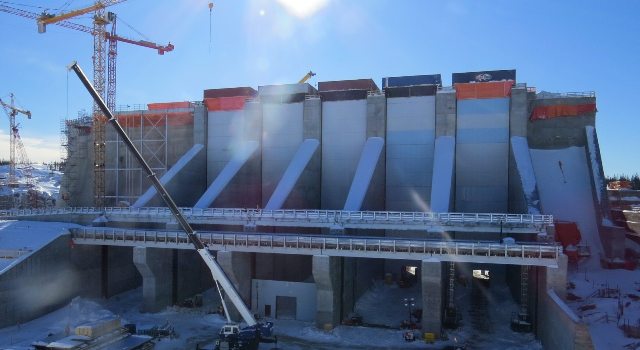
Muskrat Falls construction site could be inundated if reservoir not flooded soon
by Michael MacDonald, The Canadian Press

Flooding the dam's reservoir was postponed last week due to protests, but Nalcor CEO says flooding must start within three weeks
ST. JOHN’S, N.L.—Unless flooding of a reservoir near the Muskrat Falls hydroelectric project is completed within the next three weeks, the construction site could be inundated with water from the Churchill River as winter sets in and temperatures plunge, the man in charge of the Labrador megaproject says.
Stan Marshall, CEO of Nalcor Energy, said Nov. 2 the Crown corporation is keen to start flooding this weekend, but it is still waiting for provincial approval.
“It’s snowing up there already,” Marshall said in an interview. “We have to move soon … Winter is upon us in Labrador.”
Flooding was postponed last week when about 50 protesters descended on the site and demanded a meeting with Premier Dwight Ball, who promised a delay until after the marathon meeting that ended early Wednesday in St. John’s.
The Labrador Innu have already given their approval for the flooding, but Marshall said the province is waiting to hear from the two other aboriginal groups involved: the Nunatsiavut Government and the NunatuKavut Community Council.
“If we don’t do this, we risk losing a lot of the work that has been done,” Marshall said. “I’m sure the insurers would cancel the policy if we didn’t do that … We are now really pressed for time.”
Reached by email, the NunatuKavut council issued a brief statement saying it will submit comments to the province by the end of the week.
Nalcor’s plan is to use water from the 25-metre-deep reservoir to warm super-cooled water flowing over Muskrat Falls, which will otherwise form a dam when temperatures plunge well bellow freezing. The dam would cause flooding in and around the construction site, Marshall said.
The project, which started in 2012, is now two years behind schedule and has gone $4 billion over budget to an estimated cost of $11.4 billion.
About 700 workers had to leave the site west of Happy Valley-Goose Bay after the protesters occupied a building on Oct. 22, and then moved into the actual construction zone.
They left the site last Wednesday after Ball agreed to set up an independent advisory committee, which will include members from the three aboriginal groups and representatives from the federal, provincial and municipal governments. The committee has been asked to make recommendations to mitigate the impact of the methylmercury contamination that will result when the reservoir is flooded.
The project is upstream from 2,000 Inuit and other residents in the Lake Melville region. Critics warn of contamination if too many trees and too much soil is left to rot at the bottom of a 41-square-kilometre reservoir.
Methylmercury is a neurotoxin linked to intellectual issues in children, heart problems and other health issues.
Nalcor engineers have confirmed methylmercury levels will likely increase between 2.3 and 4.8 times in the reservoir before falling back to baseline levels over the next 15 years. As a result, Nalcor said residents in the area can eventually expect an advisory warning them to limit their consumption of fish to reduce the risks associated with ingestion of methylmercury.
The province has agreed to consider further clearing of the reservoir if needed. Some researchers have suggested the best way to prevent contamination would be to remove soil from the reservoir, which will be drained next spring.
Marshall said he’s not convinced that would work.
“As for soil removal, that has never been done anywhere,” he said, referring to previous hydroelectric projects. “That would require another environmental assessment … It would be very costly. And there’s no scientific evidence that this would be beneficial. In fact it might make things worse.”
The project’s senior biologist, Jim McCarthy, said last month that removing soil from the basin would have a bigger impact on reducing methylmercury than just removing the trees.
Marshall said about 1,500 workers have returned to work, but there is usually about 2,000 on the job there.
Aside from the flooding delay, the onset of bad weather has prompted Nalcor to delay the transfer of massive transformers from the island of Newfoundland to Labrador until next June.
Watch an aerial tour of the hydro site:
